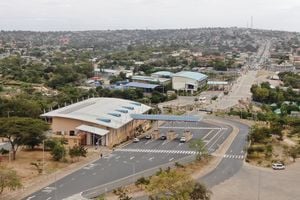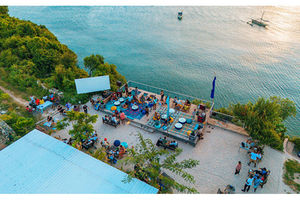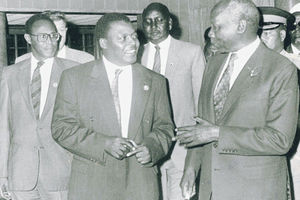
Statues are displayed at the Fortaleza, a Portuguese colonial-era fort, in the city of Luanda on November 11, 2018, the capital of Angola.
US President Joe Biden announced he will be travelling to Luanda in Angola for his maiden trip to Africa as president, which could also be his last.
Angola has been many things including producing the second most amount of oil in Africa as well as helping mediate in conflict in the Democratic Republic of Congo.
But it’s not cheap to live in. It is considered by the UN as a resource-rich, lower-middle-income and food-deficit country with a population of over 35 million.
Its capital, Luanda, was founded in 1576 by the Portuguese Paulo Dias de Novais. Today, it is known as the industrial, economic, political, administrative and religious centre of the country. Inhabitants have to pay top dollar to live better.
Top hotels in Luanda charge between $250 and $485 per night while high-range restaurants charge between $18 and $35 per a meal.
Francisco Chivela, an economist in Luanda, told The EastAfrican that the cost is partly because everything is concentrated in Luanda. That means there is less for more people from across the country. The solution, he argued, is to decentralise services, including making the country to have more than one capital.
New administrative regions
Angola has 18 provinces and 164 municipalities but as of next year, it will have 21 provinces and 325 municipalities after parliament a law in August to create new political-administrative regions.
Moxico province was split into Moxico and Kassai Zambeze, Cuando Cubango province was divided into Cuando and Cubango while Luanda gave rise to Icolo and Bengo province.
It is the most populated province in the country housing at least one third of the Angolan population.
According to experts, the city was originally designed for approximately 500,000 people.
Its population is currently estimated at 9.6 million. In 1950, the population of Luanda was 138,413. It has grown by an average of 3.86 percent per year.
In 2020, African Cities Research Consortium group ranked Luanda the fourth largest city in Africa by population in a list topped by Cairo, Lagos and Kinshasa.
Dar es Salaam is the fifth one, Addis Ababa the tenth and Nairobi the eleventh largest city in the continent while Brazzaville is ranked 34.
A UN report also explained that more than half of the Angola’s population lives on less than $2.15 per day in rural areas and due to rapid population growth, the number of people living in poverty continues to grow.
This seems to be most noticeable in Luanda.
The Etic Journal which owns the ETIC Hotels, a hotel booking platform, ranks Luanda as the world’s most expensive city for expatriates.
According to the online publication, several factors contribute to its high cost of living, including the fact that many goods are imported, the Luanda’s recovering infrastructure from years of civil war, and the oil-driven economic boom which has led to inflated prices for housing and services.
Others factor that contribute to the high cost of living in the capital city of Angola, the publication explains, is the sudden influx of expatriates, especially those working in the oil and diamond industries, has driven the demand for international goods and quality housing.
Mr Chivela explains other reasons why Luanda has a high cost of living.
He says bureaucracy in the banking system makes the cost of living high in Luanda.
“In other cities around the world, electronic payment is popular. Here in Luanda it is a rarity. You can even make purchases on the street with your phone in some cities, but here in Luanda it is still a dream,” Mr Chivela said.
In August, the consultancy firm, Mercer ranked Luanda the world’s most expensive city for expatriates in a survey which analysed the cost of living in over 200 cities taking into consideration factors such as food, housing, medical care, clothing, transport, location, leisure and entertainment among others.
In a list populated by Europe and Asian counterparts, the capital of Angola topped cities such as Hong Kong, Tokyo, Zurich, Singapore, Seoul, Geneva, Shanghai, New York City and Bern.
This is not the first time that Luanda has topped the list of the most expensive cities to live in as an expatriate. In 2017, it was ranked first ahead of Hong Kong.
In 2015, Luanda was considered the world’s most expensive city for expatriates for the third year in a row due to the high cost of rent, imported goods and security.
Mr João Saraiva, a Portuguese national, who has run a hotel business in Luanda for the last two decades, recalls an event that still slaps his mind, when a Ghanaian football player was charged $10 for a haircut in 2010, when Angola hosted the Africa Cup of Nations tournament, and the player reported the matter to the police.
“There are cities where money has a lot of value, but here in Luanda it seems that money loses its worth every day,” Saraiva said.
“Luanda is overcrowded compared to other cities in the country and the world.”
To make matters worse, there are high rates of informality, Mr Saraiva added, meaning folks in Luanda generally live hand to mouth and that cannot develop the sectors that depend on borrowing and saving culture.
The currency depreciation and the increase in gasoline prices have both fuelled inflationary pressures since mid-2023, a World Bank bulletin said adding that Angola economy is not generating enough jobs to keep up with its growing working-age population.
Africa Development Bank Group data shows that most jobs in Angola are informal (79.9 percent), and the unemployment rate is high (29.6 percent), driven by rural areas (38 percent) and youth (52.9 percent).









